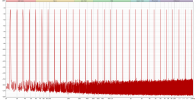My personal amplifier/space heater/weight-training device is the Nelson Pass' Aleph 1.2 monoblock. I've had this pair since mid-nineties, and while I also have other amps on hand, this one has been the primary one dedicated to music listening (although it also served double-duty in the home theater for a while). Given the reputation and published measurements (by Stereophile) I was not expecting it to measure well compared to modern amps, and it didn't disappoint 
All measurements (unless otherwise stated) were done using REW at 5W output into 8Ω load, recorded by Cosmos ADC. Balanced (XLR) input was used.
The 60Hz line frequency and harmonics may be due a ground loop, but I was unable to resolve it by connecting/disconnecting grounds, using/not using separate power supplies (power plant), USB isolators, and running the laptop from a battery. Any suggestions on what else I can try are welcome. I'll update this post if I find a way to reduce it.
1 kHz tone:

Frequency response

SMPTE 60Hz + 7kHz 4:1

CCIF 19k + 20k

Multitone

THD+N vs Frequency sweep @ 5W:

THD+N vs Power @1kHz:

All measurements (unless otherwise stated) were done using REW at 5W output into 8Ω load, recorded by Cosmos ADC. Balanced (XLR) input was used.
The 60Hz line frequency and harmonics may be due a ground loop, but I was unable to resolve it by connecting/disconnecting grounds, using/not using separate power supplies (power plant), USB isolators, and running the laptop from a battery. Any suggestions on what else I can try are welcome. I'll update this post if I find a way to reduce it.
1 kHz tone:
Frequency response
SMPTE 60Hz + 7kHz 4:1
CCIF 19k + 20k
Multitone
THD+N vs Frequency sweep @ 5W:
THD+N vs Power @1kHz:
Last edited:



